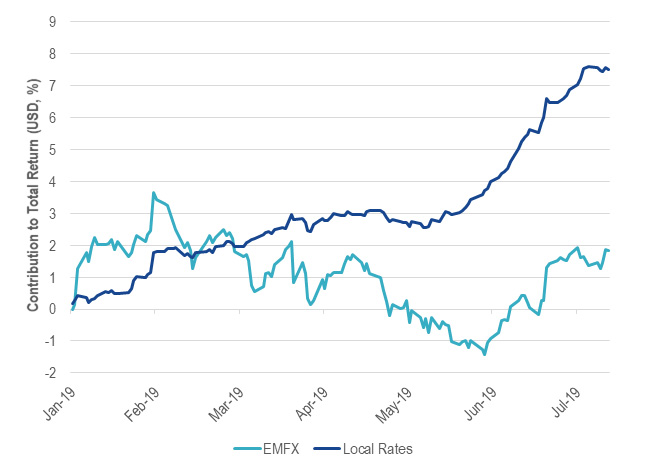EM Bonds: A Winner in the Race to Cut Rates?
29 July 2019
Share with a Friend
All fields required where indicated (*)Lower interest rates in developed markets have been the key driver of emerging markets debt returns so far this year, despite several idiosyncratic stories and emerging markets central banks that have until recently exhibited an overall tightening bias. In our view, the shift in policy globally is creating a potential runway for emerging markets currencies (EMFX) to possibly fare better versus the U.S. dollar, and for emerging markets central banks to, partly as a consequence, take a more dovish stance with regard to their own interest rate policies.
The key question is whether current interest rate levels reflect fundamentals such as expected growth and inflation, or if they are being priced to expected central bank policy in the U.S. and Europe (which may or may not reflect economic fundamentals). We believe, if current rate levels are reflective of expected fundamentals, caution may be warranted. The negative impact to EMFX of slowing growth or an impending recession would likely outweigh the incremental benefit of lower rates to emerging markets local currency bonds. Spread sectors such as corporate bonds may also underperform as the credit cycle turns and spreads and defaults increase. In our view, a more benign “goldilocks”1 scenario of continued slow growth supported by low interest rates, on the other hand, would be a more favorable environment in which we think investors may benefit from being tactical within these asset classes.
We believe that market expectations for lower rates are based on a view of central banks’ willingness to be extremely cautious about protecting growth and asset prices, and are not reflective of an impending end to the economic or credit cycle. If correct, this would be bullish for most asset classes and favor taking on more risk within fixed income portfolios. In this scenario, we believe emerging markets local currency bonds would fare particularly well. Many emerging markets central banks would have room to cut rates, potentially boosting local interest rate driven returns which have already provided the bulk of total return this year, while a weaker U.S. dollar could provide some lift to relatively stagnant EMFX returns. Even an environment of flat currency returns may be favorable for emerging market local currency bond investors, given the attractive carry the asset class currently provides with a yield of 6.7% as of June 30, 2019.
YTD EM Local Bond Returns Driven by Local Rates, While EMFX Has Lagged

Source: JP Morgan. Data as of 12/7/2019.
Emerging markets corporate bonds may also be attractive for investors not willing to assume currency risk, as returns will be anchored by U.S. rates while spreads may find support from central bank stimulus. We continue to favor the high yield segment of this market due to its attractive risk/reward in light of healthy and improving credit fundamentals.
For more on a fixed income portfolio could be positioned in the current environment, see CEO Jan van Eck’s latest investment outlook: Is There Enough Risk in Your Fixed Income Portfolio?
1A goldilocks economy is an economy that is not so hot that it causes inflation and not so cold that it causes a recession.
Important Disclosure
This is a marketing communication. Please refer to the prospectus of the UCITS and to the KID before making any final investment decisions.
This information originates from VanEck (Europe) GmbH, which has been appointed as distributor of VanEck products in Europe by the Management Company VanEck Asset Management B.V., incorporated under Dutch law and registered with the Dutch Authority for the Financial Markets (AFM). VanEck (Europe) GmbH with registered address at Kreuznacher Str. 30, 60486 Frankfurt, Germany, is a financial services provider regulated by the Federal Financial Supervisory Authority in Germany (BaFin).
The information is intended only to provide general and preliminary information to investors and shall not be construed as investment, legal or tax advice VanEck (Europe) GmbH, VanEck Switzerland AG, VanEck Securities UK Limited and their associated and affiliated companies (together “VanEck”) assume no liability with regards to any investment, divestment or retention decision taken by the investor on the basis of this information. The views and opinions expressed are those of the author(s) but not necessarily those of VanEck. Opinions are current as of the publication date and are subject to change with market conditions. Certain statements contained herein may constitute projections, forecasts and other forward-looking statements, which do not reflect actual results. Information provided by third party sources is believed to be reliable and have not been independently verified for accuracy or completeness and cannot be guaranteed. Brokerage or transaction fees may apply.
All performance information is based on historical data and does not predict future returns. Investing is subject to risk, including the possible loss of principal.
No part of this material may be reproduced in any form, or referred to in any other publication, without express written permission of VanEck.
© VanEck (Europe) GmbH / VanEck Asset Management B.V.
Sign-up for our ETF newsletter
Related Insights
Related Insights
16 April 2024
15 April 2024
04 March 2024
12 February 2024
01 February 2024





